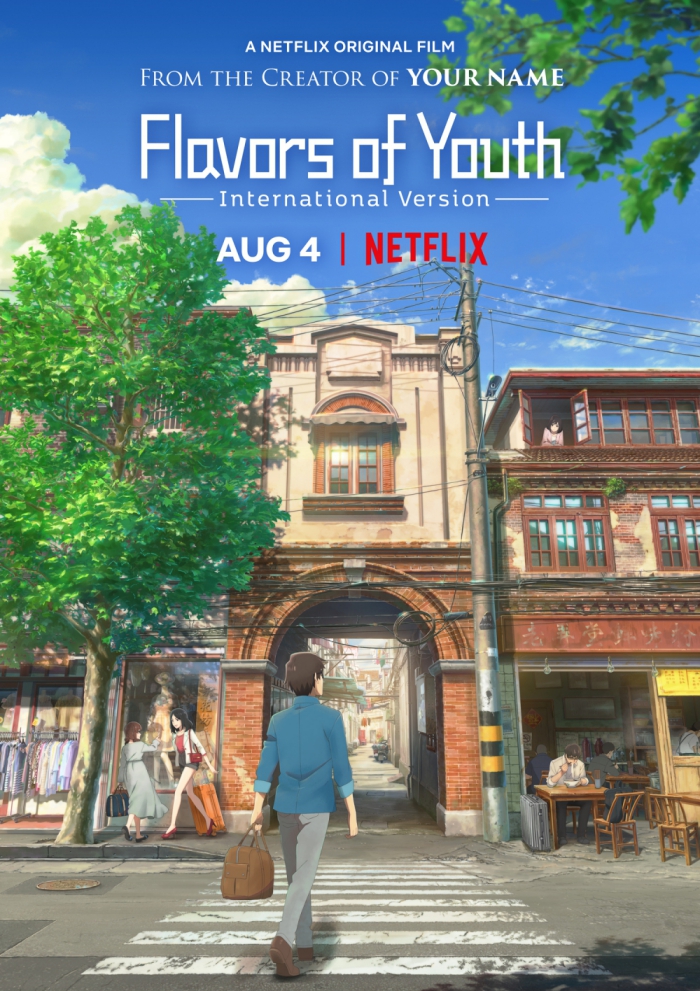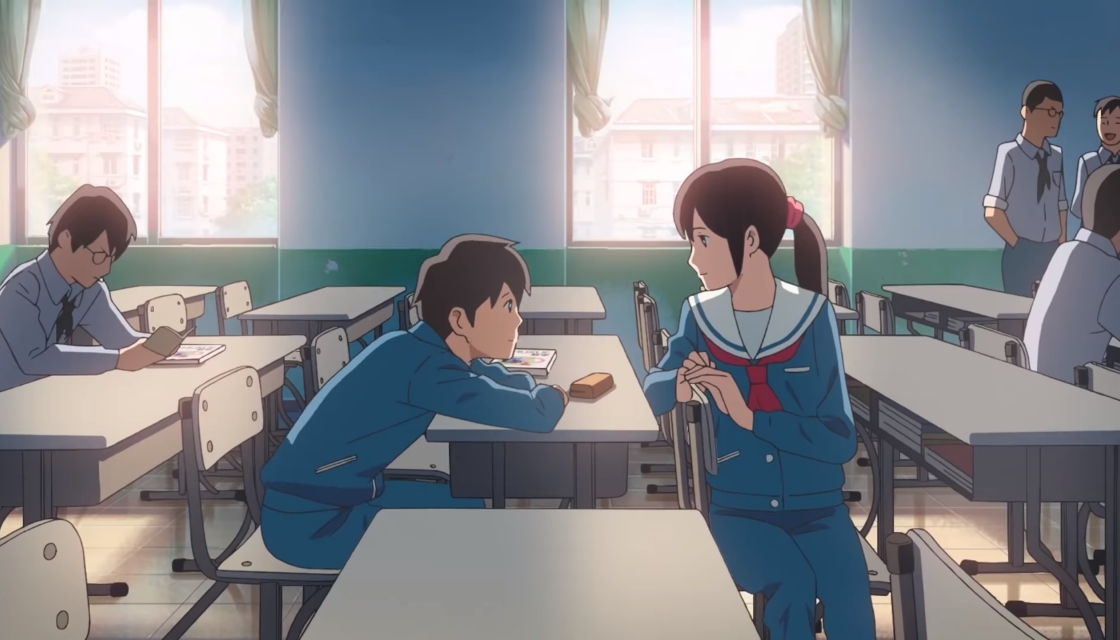Anime short films are a rare breed but while there can be too many cooks in the kitchen, in the case of Flavors of Youth it works. Much like a three-course meal, the first film Hidamari no Ch?shoku (Rice Noodles) is a great appetizer. The main course Chiisana Fashion Show (A Little Fashion Show) serves as the strongest peak by far, and Shanghai Koi (Shanghai Love Story) is a sweet little dessert to finish off. The Chinese idiom (????) that states the four basic necessities of life: food, clothing, housing, and transportation serves as a tagline, and to be fair, each of the three shorts does a good job of sticking to their assigned part. However, the theme that weighs most heavily all three shorts is the inexorable passage of time.
In Hidamari no Ch?shoku we meet Shaomin who currently lives in bleak Beijing. It’s not the most exciting life but it is a life that pays well enough to be able to fly. His daily routine seems to consist largely of going to work, getting restaurant food, and going home. The town of his youth, however, is or rather was a far more happy place than his current situation. Shaomin’s favorite food, San Xian noodle soup, is the physical manifestation of his memories. In the present, he gets mass produced noodles that remind him time and again about the kind of noodles he used to have growing up. He tells about how growing up, there used to be a noodle shop that was run by a master who’s noodle soup was legendary. It’s here where we see Director Xiaoxing Yi and CoMix Wave Films get a bit indulgent when they animate the preparation process. It’s difficult to describe how animated food can cause mouths to water with anticipation, but at the end of the scene, I was feeling hungry.
Despite the legendary reputation of the shop, due to reasons that aren’t clearly stated, the shop owners are forced out. Shaomin hints that the owner/cook was somehow disgraced but even if they avoid the Communist censors, the period would fit in around a more turbulent time in China’s history. Although the shop is forced to close, Shaomin does find another place run by a lady who might not have the skills of the disgraced master, but she puts plenty of love in her food. It’s also at this shop where every day, Shaomin watches his crush ride by every day. He never actually says hello though. Still, even the kindly shop lady isn’t immune to the changing times. Her husband orders a menu change and starts remodeling the shop over her objections. Things get a bit more heated once there is a fight that goes sideways, but in the end Hidamari no Ch?shoku is a story about how youth fades, memories fade, people die, but things also move on. Legacy doesn’t have to fade into myth and legend if someone can carry the torch. What was once thought lost might be found again.
The second short Chiisana Fashion Show directed by Yoshitaka Takeuchi takes place in Guangzhou and focuses on Yi Lin along with her sister Lulu, and her manager Steve. Of the three shorts, Chiisana Fashion Show is at once the most fantastical and the strongest story of the three. It’s fantastical in the sense that Yi Lin not only has a sister, but she also gets to be the undisputed head of her household. It’s also the strongest narratively because unlike the other Chinese directors, Takeuchi has no sense of nostalgia to really bank on and thus has a more focused story to tell. To be fair, Takeuchi visited Guangzhou and led his team to create a credible animated city. Willful and determined, Yi Lin does emerge as the titular star of the film, at least to American viewers judging by the audible cheers for her. Yi Lin might be a fashion model but she didn’t just rely on good looks, the woman puts work into her craft. She works not for fame as an end, but as a means to provide for her sister and keep them as a family after their parents passed away. It also helps immensely that she is a good person who treats staffers like people instead of peons.
When a younger rival emerges she doesn’t take it lying down, but she doesn’t resort to sabotage either. She starts running with renewed fervor, but she cannot outrun time and in her efforts to stay young, she overcompensates and crashes at a critical moment. We already knew her ‘boyfriend’ was a sleazy jerk but if the nameless state wasn’t enough of a clue he does ride off with the young rival. Fortunately, Yi Lin is a smart woman and hardly cared for him and wasted little in terms of tears. What really gives her conflict though is trying to manage to have it all while connecting with Lulu. Her manager Steve does help out when he can but he can only do so much. Yi Lin fails early on, often letting work get in the way of quality time but when she hits bottom, her relationship with Lulu gets frayed. Mostly it is because, after one failure, Yi Lin forgets herself and starts grasping for a career change. Lulu helps Yi Lin out of her rut, and while a bit predictable, it was well executed. You don’t have to be number one, you just be your best.
The third short Shanghai Koi (Shanghai Love Story) by Director Haolin Li, centers around Li Mo, a recent graduate and struggling architect. Li Mo starts out as kind of an ass. At worst, he seems to lash out at those around him because of his own unhappiness and at best, he keeps acting on his worst impulses while fulfilling his best intentions. It’s during his move to a new apartment that he comes upon an old cassette tape. His childhood friend says that he gave it to Li Mo’s mom while Li Mo was in a marathon study session for exams. Apparently, it had been buried in a box and forgotten about all this time. The cassette apparently contains the last communique from his childhood love Xiao Yu. Thus begins Li Mo’s journey down memory lane with a healthy dose of regret. Suffice to say Li Mo’s younger self-wasn’t much nicer than the man we have already met. Nevertheless, there is a point to his vexing personality as his eventual mea culpa is more satisfying for it. It felt similar to another anime film about a missed connection, but perhaps it was inevitable given how the Chinese directors had wanted to work with Makoto Shinkai.

Overall, all three shorts were well animated by CoMix Wave Films. It is rather ironic that a Chinese and Japanese co-production would end up streaming on western streaming service like Netflix. I worry that although I found the shorts to be great in their own ways, that a western and to a lesser extent a non-Chinese Mainlander audience will miss the cultural cues. Blackballing talented folks was, and in some ways is, still a thing in the People’s Republic of China. The one-child policy also raises the stakes when harm comes to children as the knock-down effects on the family’s future can be drastic. Lastly, but certainly not least, is how the education system in the People’s Republic of China works and how much where you end up has an outsized impact on your future. Nevertheless, their collective dedication to document each locale accurately and faithfully across time, as a person who’s been there recently and in the 1990s, brought me chills. Hopefully, that helps to transport the audience to a place and time. My only minor issue is that all of it was cleaner and more idyllic than reality. Namely, there is a noticeable lack of smog and pollution. It isn’t a knock on the film as it is a knock on the unfortunate reality that none of the three locations are that clean.
Flavors of Youth will be streaming through Netflix in most markets on 8/4/2018. Also, there is a post-credits scene.

